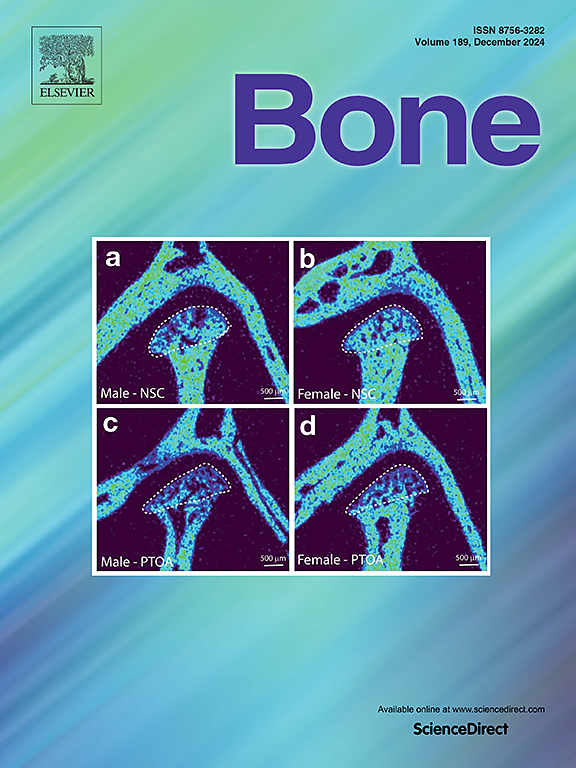Detailed characterization of bone marrow adipose tissue mesenchymal stem cells in healthy donor, Fanconi anemia, and acute myeloid leukemia
IF 3.5
2区 医学
Q2 ENDOCRINOLOGY & METABOLISM
引用次数: 0
Abstract
Bone marrow is a complex tissue featuring distinct cellular organization and diverse cell types. Bone marrow adipose tissue (BMAT) is a dynamic component crucial for tissue function and disease processes. This study explores differences between bone marrow-derived mesenchymal stem cells (BM-MSCs) and BMAT-derived mesenchymal stem cells (BMAT-MSCs), isolated from the same cavity, examining their differentiation potential and secretory profiles. BM-MSCs and BMAT-MSCs both exhibit classical mesenchymal characteristics, with over 90 % positivity for markers such as CD105 and CD29. Notably, BMAT-MSCs display significantly higher differentiation potential than BM-MSCs, with enhanced osteogenic and adipogenic capabilities, as indicated by increased calcium accumulation and lipid storage. In Fanconi anemia (FA) and acute myeloid leukemia (AML), osteogenic potential is limited, indicating impaired differentiation under these pathological conditions. Gene expression analysis of adipogenic molecules and metabolic regulators revealed significant differences in expression profile between BM- and BMAT-MSCs, particularly during adipogenic differentiation, indicating distinct characteristics that were more notable in FAs and AMLs. Furthermore, metabolomic profiling of BM plasma, using GC–MS for in-vivo niche reflection, and lipid analysis via LC-qTOF-MS show significant lipidomic alterations in patient samples, highlighting metabolic dysregulation and lipid remodeling. Lipid-mediated signaling and membrane composition changes appear integral to disease mechanisms. In conclusion, this study highlights the distinctive molecular and metabolomic profiles and adaptive mechanisms of BM- and BMAT-MSCs in bone marrow pathologies.

健康供体、范可尼贫血和急性髓系白血病骨髓脂肪组织间充质干细胞的详细特征。
骨髓是一个复杂的组织,具有独特的细胞组织和多种细胞类型。骨髓脂肪组织(BMAT)是组织功能和疾病过程中至关重要的动态成分。本研究探讨了骨髓来源的间充质干细胞(BM-MSCs)和bmat来源的间充质干细胞(BMAT-MSCs)之间的差异,从同一腔中分离,检查它们的分化潜力和分泌谱。BM-MSCs和BMAT-MSCs均表现出典型的间充质特征,CD105和CD29等标记物的阳性率超过90% %。值得注意的是,BMAT-MSCs比BM-MSCs表现出明显更高的分化潜力,具有增强的成骨和成脂能力,这表明钙积累和脂质储存增加。在范可尼贫血(FA)和急性髓性白血病(AML)中,成骨潜能有限,表明在这些病理条件下分化受损。成脂分子和代谢调节因子的基因表达分析显示,BM-和BMAT-MSCs之间的表达谱存在显著差异,尤其是在成脂分化过程中,这表明在FAs和AMLs中更为显著的明显特征。此外,BM血浆代谢组学分析,使用GC-MS进行体内生态位反射,通过LC-qTOF-MS进行脂质分析,显示患者样本中显著的脂质组学改变,突出了代谢失调和脂质重塑。脂质介导的信号和膜组成的变化似乎是疾病机制的组成部分。总之,本研究强调了BM-和BMAT-MSCs在骨髓病理中的独特分子和代谢组学特征以及适应机制。
本文章由计算机程序翻译,如有差异,请以英文原文为准。
求助全文
约1分钟内获得全文
求助全文
来源期刊

Bone
医学-内分泌学与代谢
CiteScore
8.90
自引率
4.90%
发文量
264
审稿时长
30 days
期刊介绍:
BONE is an interdisciplinary forum for the rapid publication of original articles and reviews on basic, translational, and clinical aspects of bone and mineral metabolism. The Journal also encourages submissions related to interactions of bone with other organ systems, including cartilage, endocrine, muscle, fat, neural, vascular, gastrointestinal, hematopoietic, and immune systems. Particular attention is placed on the application of experimental studies to clinical practice.
 求助内容:
求助内容: 应助结果提醒方式:
应助结果提醒方式:


